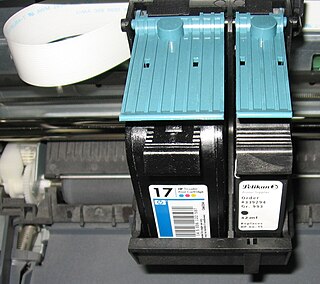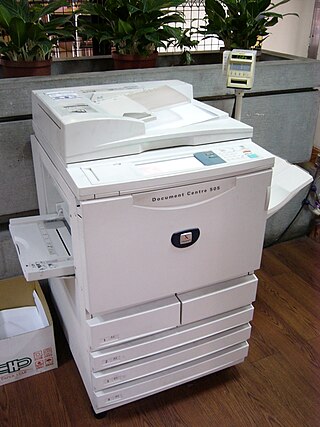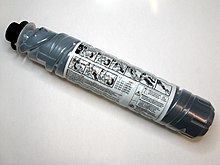
Laser printing is an electrostatic digital printing process. It produces high-quality text and graphics by repeatedly passing a laser beam back and forth over a negatively charged cylinder called a "drum" to define a differentially charged image. The drum then selectively collects electrically charged powdered ink (toner), and transfers the image to paper, which is then heated to permanently fuse the text, imagery, or both to the paper. As with digital photocopiers, laser printers employ a xerographic printing process. Laser printing differs from traditional xerography as implemented in analog photocopiers in that in the latter, the image is formed by reflecting light off an existing document onto the exposed drum.

Stationery refers to writing materials, including cut paper, envelopes, writing implements, continuous form paper, and other office supplies. Stationery includes materials to be written on by hand or by equipment such as computer printers.

Asphalt concrete is a composite material commonly used to surface roads, parking lots, airports, and the core of embankment dams. Asphalt mixtures have been used in pavement construction since the beginning of the twentieth century. It consists of mineral aggregate bound together with bitumen, laid in layers, and compacted.

Xerography is a dry photocopying technique. Originally called electrophotography, it was renamed xerography—from the Greek roots ξηρόςxeros, meaning "dry" and -γραφία-graphia, meaning "writing"—to emphasize that unlike reproduction techniques then in use such as cyanotype, the process of xerography used no liquid chemicals.
An electrofax was a type of fax. It involved electrostatic printer and copier technology, where an image was formed directly on the paper, instead of first on a drum, then transferred to paper, as it would be in xerography. It was used in the United States from the 1950s through the 1980s.

Powder coating is a type of coating that is applied as a free-flowing, dry powder. Unlike conventional liquid paint, which is delivered via an evaporating solvent, powder coating is typically applied electrostatically and then cured under heat or with ultraviolet light. The powder may be a thermoplastic or a thermosetting polymer. It is usually used to create a thick, tough finish that is more durable than conventional paint. Powder coating is mainly used for coating of metal objects, particularly those subject to rough use. Advancements in powder coating technology like UV-curable powder coatings allow for other materials such as plastics, composites, carbon fiber, and medium-density fibreboard (MDF) to be powder coated, as little heat or oven dwell time is required to process them.
Nano-thermite or super-thermite is a metastable intermolecular composite (MIC) characterized by a particle size of its main constituents, a metal fuel and oxidizer, under 100 nanometers. This allows for high and customizable reaction rates. Nano-thermites contain an oxidizer and a reducing agent, which are intimately mixed on the nanometer scale. MICs, including nano-thermitic materials, are a type of reactive materials investigated for military use, as well as for general applications involving propellants, explosives, and pyrotechnics.

An ink cartridge or inkjet cartridge is a component of an inkjet printer that contains ink to be deposited onto paper during printing. It consists of one or more ink reservoirs and can include electronic contacts and a chip to exchange information with the printer.
Compatible ink is manufactured by third-party manufacturers and is designed to work in designated printers without infringing on patents of printer manufacturers. Compatible inks and toners may come in a variety of packaging including sealed plastic wraps or taped plastic wraps. Regardless of packaging, compatible products are generally priced lower than original equipment manufacturer (OEM) brand inks and toners.
Dynamic Cassette International (DCI) is an internationally recognised Boston, Lincolnshire, UK based ink cartridge and laser toner manufacturing company, producing products under the Jet Tec brand name. DCI is the sole UK manufacturer of compatible ink cartridges. DCI is notable for winning the Queen's Award for Enterprise: Innovation in 2004 and the Queen's Award for Export and being one of the biggest employers in Boston, employing over 300 staff at its 40,000 square metres factory. The company is currently Europe's largest manufacturer of compatible inkjet cartridges and has a turnover in excess of £20 million.

Filler materials are particles added to resin or binders that can improve specific properties, make the product cheaper, or a mixture of both. The two largest segments for filler material use is elastomers and plastics. Worldwide, more than 53 million tons of fillers are used every year in application areas such as paper, plastics, rubber, paints, coatings, adhesives, and sealants. As such, fillers, produced by more than 700 companies, rank among the world's major raw materials and are contained in a variety of goods for daily consumer needs. The top filler materials used are ground calcium carbonate (GCC), precipitated calcium carbonate (PCC), kaolin, talc, and carbon black.

Toner refilling is the practice of refilling empty laser printer toner cartridges with new toner powder. This enables the cartridge to be reused, saving the cost of a complete new cartridge and the impact of the waste and disposal of the old one.

A photocopier is a machine that makes copies of documents and other visual images onto paper or plastic film quickly and cheaply. Most modern photocopiers use a technology called xerography, a dry process that uses electrostatic charges on a light-sensitive photoreceptor to first attract and then transfer toner particles onto paper in the form of an image. The toner is then fused onto the paper using heat, pressure, or a combination of both. Copiers can also use other technologies, such as inkjet, but xerography is standard for office copying.

A toner cartridge, also called laser toner, is the consumable component of a laser printer. Toner cartridges contain toner powder, a fine, dry mixture of plastic particles, carbon, and black or other coloring agents that make the actual image on the paper. The toner is transferred to paper via an electrostatically charged drum unit, and fused onto the paper by heated rollers during the printing process. It will not stain like ink cartridges, but it can get messy if handled improperly.

The RemaxWorld Expo is an annual trade show comprising vendors from within the print consumables industry. The event began in 2007, resulting from a joint venture between the China Council for the Promotion of International Trade (CCPIT) and Recycling Times Media Corporation. Centered in Zhuhai, widely recognized as being the print consumables capital of the world, the exhibition currently takes place in the newly constructed Zhuhai International Convention & Exhibition Center. In 2015, the show accommodated 463 exhibitors and 13,938 visitors from 83 countries.
Katun is a supplier of OEM-compatible imaging consumables and supplies for office equipment.
An electrostatic plotter is a type of plotter that draws images on paper with an electrostatic process. They are most frequently used for Computer-Aided Engineering (CAE), producing raster images via either a Liquid Toner or a Dry Toner model.

A variety of processes, equipment, and materials are used in the production of a three-dimensional object via additive manufacturing. 3D printing is also known as additive manufacturing, because the numerous available 3D printing process tend to be additive in nature, with a few key differences in the technologies and the materials used in this process.
The health and safety hazards of nanomaterials include the potential toxicity of various types of nanomaterials, as well as fire and dust explosion hazards. Because nanotechnology is a recent development, the health and safety effects of exposures to nanomaterials, and what levels of exposure may be acceptable, are subjects of ongoing research. Of the possible hazards, inhalation exposure appears to present the most concern, with animal studies showing pulmonary effects such as inflammation, fibrosis, and carcinogenicity for some nanomaterials. Skin contact and ingestion exposure, and dust explosion hazards, are also a concern.
Research on the health and safety hazards of 3D printing is new and in development due to the recent proliferation of 3D printing devices. In 2017, the European Agency for Safety and Health at Work has published a discussion paper on the processes and materials involved in 3D printing, potential implications of this technology for occupational safety and health and avenues for controlling potential hazards.














